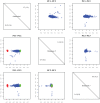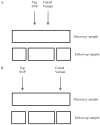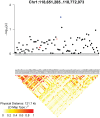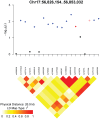Transferability and fine-mapping of genome-wide associated loci for adult height across human populations
- PMID: 20027299
- PMCID: PMC2792725
- DOI: 10.1371/journal.pone.0008398
Transferability and fine-mapping of genome-wide associated loci for adult height across human populations
Abstract
Human height is the prototypical polygenic quantitative trait. Recently, several genetic variants influencing adult height were identified, primarily in individuals of East Asian (Chinese Han or Korean) or European ancestry. Here, we examined 152 genetic variants representing 107 independent loci previously associated with adult height for transferability in a well-powered sample of 1,016 unrelated African Americans. When we tested just the reported variants originally identified as associated with adult height in individuals of East Asian or European ancestry, only 8.3% of these loci transferred (p-values < or =0.05 under an additive genetic model with directionally consistent effects) to our African American sample. However, when we comprehensively evaluated all HapMap variants in linkage disequilibrium (r(2) > or = 0.3) with the reported variants, the transferability rate increased to 54.1%. The transferability rate was 70.8% for associations originally reported as genome-wide significant and 38.0% for associations originally reported as suggestive. An additional 23 loci were significantly associated but failed to transfer because of directionally inconsistent effects. Six loci were associated with adult height in all three groups. Using differences in linkage disequilibrium patterns between HapMap CEU or CHB reference data and our African American sample, we fine-mapped these six loci, improving both the localization and the annotation of these transferable associations.
Conflict of interest statement
Figures





Similar articles
-
Discovery and fine-mapping of height loci via high-density imputation of GWASs in individuals of African ancestry.Am J Hum Genet. 2021 Apr 1;108(4):564-582. doi: 10.1016/j.ajhg.2021.02.011. Epub 2021 Mar 12. Am J Hum Genet. 2021. PMID: 33713608 Free PMC article.
-
Transferability and fine mapping of genome-wide associated loci for lipids in African Americans.BMC Med Genet. 2012 Sep 21;13:88. doi: 10.1186/1471-2350-13-88. BMC Med Genet. 2012. PMID: 22994408 Free PMC article.
-
Whole-exome imputation of sequence variants identified two novel alleles associated with adult body height in African Americans.Hum Mol Genet. 2014 Dec 15;23(24):6607-15. doi: 10.1093/hmg/ddu361. Epub 2014 Jul 15. Hum Mol Genet. 2014. PMID: 25027330 Free PMC article.
-
Patterns of linkage disequilibrium in different populations: implications and opportunities for lipid-associated loci identified from genome-wide association studies.Curr Opin Lipidol. 2010 Apr;21(2):104-15. doi: 10.1097/MOL.0b013e3283369e5b. Curr Opin Lipidol. 2010. PMID: 20125009 Review.
-
Accounting for linkage disequilibrium in association analysis of diverse populations.Genet Epidemiol. 2014 Apr;38(3):265-73. doi: 10.1002/gepi.21788. Epub 2014 Jan 26. Genet Epidemiol. 2014. PMID: 24464495 Review.
Cited by
-
Novel functional insights into ischemic stroke biology provided by the first genome-wide association study of stroke in indigenous Africans.Genome Med. 2024 Feb 5;16(1):25. doi: 10.1186/s13073-023-01273-5. Genome Med. 2024. PMID: 38317187 Free PMC article.
-
Interaction between Metabolic Genetic Risk Score and Dietary Fatty Acid Intake on Central Obesity in a Ghanaian Population.Nutrients. 2020 Jun 27;12(7):1906. doi: 10.3390/nu12071906. Nutrients. 2020. PMID: 32605047 Free PMC article.
-
Composite Selection Signals for Complex Traits Exemplified Through Bovine Stature Using Multibreed Cohorts of European and African Bos taurus.G3 (Bethesda). 2015 Apr 30;5(7):1391-401. doi: 10.1534/g3.115.017772. G3 (Bethesda). 2015. PMID: 25931611 Free PMC article.
-
Expression levels of LCORL are associated with body size in horses.PLoS One. 2013;8(2):e56497. doi: 10.1371/journal.pone.0056497. Epub 2013 Feb 13. PLoS One. 2013. PMID: 23418579 Free PMC article.
-
A genome scan for genes underlying adult body size differences between Central African hunter-gatherers and farmers.Hum Genet. 2018 Jul;137(6-7):487-509. doi: 10.1007/s00439-018-1902-3. Epub 2018 Jul 14. Hum Genet. 2018. PMID: 30008065
References
-
- Fisher RA. The correlation between relatives on the supposition of Mendelian inheritance. Trans R Soc Edin. 1918;52:399–433.
-
- Macgregor S, Cornes BK, Martin NG, Visscher PM. Bias, precision and heritability of self-reported and clinically measured height in Australian twins. Hum Genet. 2006;120:571–580. - PubMed
-
- Silventoinen K, Sammalisto S, Perola M, Boomsma DI, Cornes BK, et al. Heritability of adult body height: a comparative study of twin cohorts in eight countries. Twin Res. 2003;6:399–408. - PubMed
-
- Wu X, Cooper RS, Boerwinkle E, Turner ST, Hunt S, et al. Combined analysis of genomewide scans for adult height: results from the NHLBI Family Blood Pressure Program. Eur J Hum Genet. 2003;11:271–274. - PubMed
Publication types
MeSH terms
Grants and funding
LinkOut - more resources
Full Text Sources

